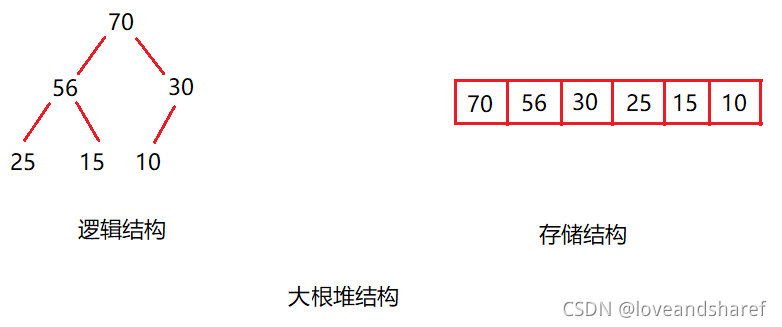C语言 深入解读数据结构之堆的实现
堆的概念与结构
概念:如果有一个关键码的集合K={ k0,k1 ,k2 ,…,kn-1 },把它的所有元素按完全二叉树的顺序存储方式存储 在一个一维数组中,并满足K i<=K 2*i+1且Ki<=K 2*i+2(K i>=K 2*i+1且Ki>=K 2*i+2) i = 0,1,2...,则称为小堆(或大堆)。将根节点最大的堆叫做最大堆或大根堆,根节点最小的堆叫做最小堆或小根堆。
性质:
- 堆中某个节点的值总是不大于或不小于其父节点的值;
- 堆总是一棵完全二叉树。
结构:
1.大堆

2.小堆

堆(大根堆)的实现:
堆的接口:
#pragma once
#include<stdio.h>
#include<stdlib.h>
#include<assert.h>
#include<stdbool.h>
typedef int HPDataType;
typedef struct Heap
{
HPDataType* a;
int size;
int capacity;
}HP;
//堆的创建
void HeapInit(HP*hp);
//堆的销毁
void HeapDestroy(HP*hp);
//交换数值
void Swap(HPDataType *px, HPDataType *py);
//向上调整
void AdjustUp(int *a,int child);
//向下调整
void AdjustDown(int *a, int n, int parent);
//堆的插入
void HeapPush(HP*hp,HPDataType x);
//堆的删除
void HeapPop(HP*hp);
//取堆顶的数据
HPDataType HeapTop(HP*hp);
//打印堆
void HeapPrint(HP*hp);
//堆的判空
bool HeapEmpty(HP*hp);
//堆的数据个数
int HeapSize(HP*hp);
堆的创建:
void HeapInit(HP*hp)
{
assert(hp);
hp->a=NULL;
hp->capacity=hp->size=0;
}
堆的销毁:
void HeapDestroy(HP*hp)
{
assert(hp);
free(hp->a);
hp->capacity=hp->size=0;
}
交换数值:
void Swap(HPDataType*px, HPDataType*py)
{
HPDataType tmp = *px;
*px=*py;
*py=tmp;
}
向上调整:
void AdjustUp(int*a, int child)
{
assert(a);
int parent = (child - 1) / 2;
while (child > 0)
{
if (a[child] > a[parent])
{
//交换数值
Swap(&a[child], &a[parent]);
child = parent;
parent = (child - 1) / 2;
}
else
{
break;
}
}
}
堆得插入:
void HeapPush(HP*hp,HPDataType x)
{
assert(hp);
if(hp->capacity==hp->size)
{
size_t newCapacity=hp->capacity==0?4:hp->capacity*2;
HPDataType * tmp=(HPDataType*)realloc(hp->a,newCapacity*sizeof(HPDataType));
if(tmp==NULL)
{
printf("realloc is fail\n");
}
hp->a=tmp;
hp->capacity=newCapacity;
}
hp->a[hp->size-1]=x;
hp->size++;
//向上调整
AdjusiUp(hp->a,hp->size-1);
}
向下调整:
void AdjustDown(int *a,int n,int parent)
{
int child=parent*2+1;
while(child<n)
{
//比较左孩子还是右孩子大
if(child+1<n && a[child+1]>a[child])
{
child++;
}
if(a[child]>a[parent])
{
Swap(&a[child],&a[parent]);
parent=child;
child=parent*2+1;
}
else
{
break;
}
}
}
堆的判空:
bool HeapEmpty(HP*hp)
{
assert(hp);
return hp->size==0;
}
堆的删除:
void HeapPop(HP*hp)
{
assert(hp);
//堆的判空
assert(!HeapEmpty(hp));
//交换数值
Swap(&hp->a[0], &hp->a[hp->size - 1]);
hp->size--;
//向下调整
AdjustDown(hp->a, hp->size, 0);
}
取堆顶的数据:
HPDataType HeapTop(HP*hp)
{
assert(hp);
assert(!HeapEmpty(hp));
return hp->a[0];
}
打印堆:
void HeapPrint(HP*hp)
{
assert(hp);
assert(!HeapEmpty(hp));
for(int i=0; i<hp->size;i++)
{
printf("%d",hp->a[i]);
}
printf("\n");
}
堆的数据个数:
int HeapSize(HP*hp)
{
assert(hp);
return hp->size;
}
以上就是对堆的讲解与操作实现。
感谢老铁看到这里,如果文章对你有用的话请给我一个赞支持一下,感激不尽!
在下才疏学浅,一点浅薄之见,欢迎各位大佬指点。
以上就是C语言 深入解读数据结构之堆的实现的详细内容,更多关于C语言 数据结构的资料请关注海外IDC网其它相关文章!
【文章出处:防御服务器 】